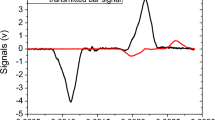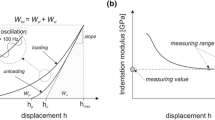Abstract
The aim of this research is to investigate the natural self-healing of mortars using air-flow measurements through a single crack of controlled geometry. Mortars were made with water–cement (W/C) ratios of 0.35, 0.45 and 0.60. For each type of mortar, three crack categories were created: 50 ± 15, 105 ± 15 and 220 ± 35 μm. Mortars were cracked at the age of 28 days and 6 months. Cracked mortars were stored in air at 23 °C and 100 % R.H. for up to 5 months to simulate the environmental conditions for open-air above-ground concrete structures. During the first month, the kinetics of self-healing is noticeably faster. The self-healing mechanism mainly involves carbonation and the formation of secondary hydration products in the crack volume. For fine cracks (50 μm), the self-healing rate is slow (5–10 μm/month). For larger cracks (>200 μm), the self-healing rate is faster (15–30 μm/month), as there is no space limitation for the formation of self-healing products and also because the effective crack opening remains high enough for the supply of external CO2 and water. For crack openings higher than 300 μm, the final natural self-healing level is less than 20 % after 5 months. For the mortar tested, age at the time of cracking only plays a minor role on self-healing kinetics.

















Similar content being viewed by others
References
Jang SY, Kim BS, Oh BH (2011) Effect of crack width on chloride diffusion coefficient of concrete by steady-state migration tests. Cem Concr Res 41(1):9–19
Picandet V, Kheidji A, Bellegou H (2009) Crack effects on gas and water permeability of concretes. Cem Concr Res 39(6):537–547
Picandet V, Khelidji A, Bastian G (2001) Effect of axial compressive damage on gas permeability of ordinary and high-performance concrete. Cem Concr Res 31(11):1525–1532
Ismail M, Toumi A, François R, Gagné R (2008) Effect of crack opening on the local diffusion of chloride in cracked mortar samples. Cem Concr Res 38(8):1106–1111
Ismail M, Toumi A, François R, Gagné R (2004) Effect of crack opening on the local diffusion of chloride in inert materials. Cem Concr Res 34(4):711–716
Boulay C, Dal Pont S, Belin P (2009) Real-time evolution of electrical resistance in cracking concrete. Cem Concr Res 39(9):825–831
Hearn N (1998) Self-healing, autogenous healing and continued hydration: what is the difference? Mater Struct 31(8):563–567
Hearn N, Detwiler RJ, Sframedi C (1994) Water permeability and microstructure of three old concretes. Cem Concr Res 24(4):633–640
Jacobsen S, Marchand J, Hornain H (1995) SEM observation of the microstructure of frost deteriorated and self-healed concretes. Cem Concr Res 25(8):1781–1790
Edvardsen C (1999) Water permeability and autogenous healing of crack in concrete. ACI Mater J 96(4):448–454
Meftah F, Dal Pont S, Schrefler BA (2012) A three-dimensional staggered finite element approach for random parametric modeling of thermo-hygral coupled phenomena in porous media. Int J Numer Anal Meth Geomech 36(5):574–596
Neville A (2002) Autogenous healing—a concrete miracle? Concr Int 24(11):76–82
Reinhardt H-W, Jooss M (2003) Permeability and self-healing of cracked concrete as a function of temperature and crack width. Cem Concr Res 33(7):981–985
Ismail M, Gagné R, François R, Toumi A (2006) Measurement and modeling of gas transfer in cracked mortars. Mater Struct 39(1):43–52
Gagné R, François R, Masse P (2001) Chloride penetration testing of cracked mortar samples. In: Banthia N, Sakai K, Gjorv OE (eds) Concrete under severe conditions, vol 1, Vancouver, pp 198–205
Acknowledgments
The authors acknowledge the financial support of the Natural Sciences and Engineering Research Council of Canada.
Author information
Authors and Affiliations
Corresponding author
Rights and permissions
About this article
Cite this article
Gagné, R., Argouges, M. A study of the natural self-healing of mortars using air-flow measurements. Mater Struct 45, 1625–1638 (2012). https://doi.org/10.1617/s11527-012-9861-y
Received:
Accepted:
Published:
Issue Date:
DOI: https://doi.org/10.1617/s11527-012-9861-y




